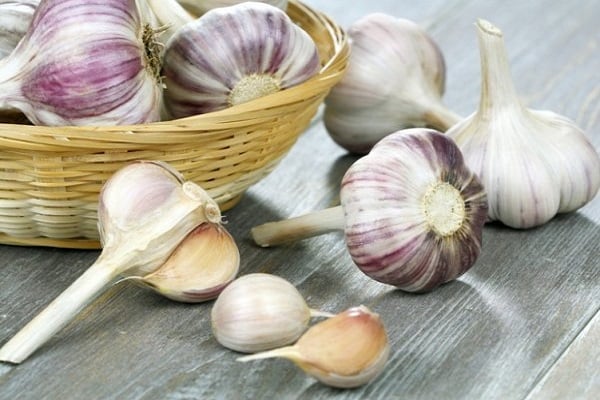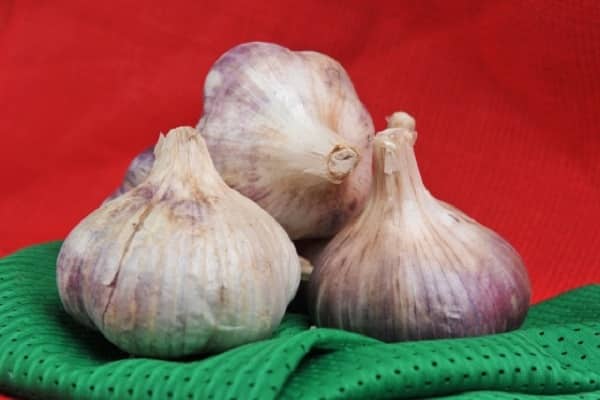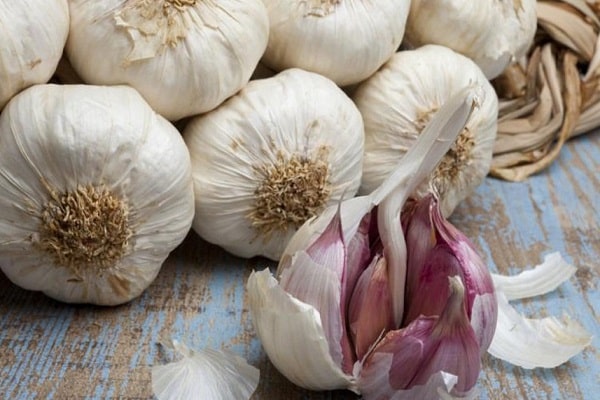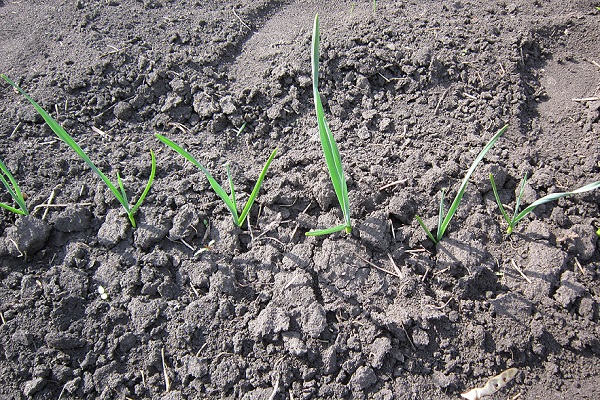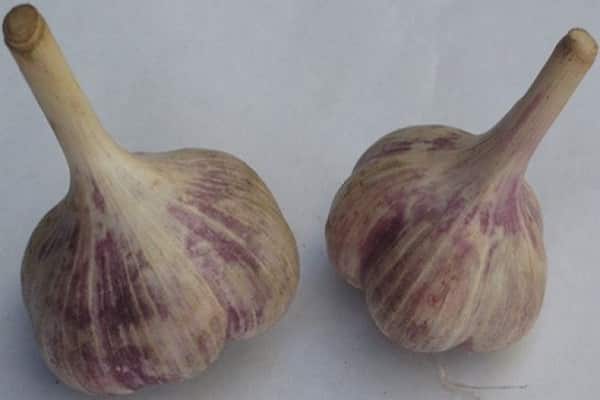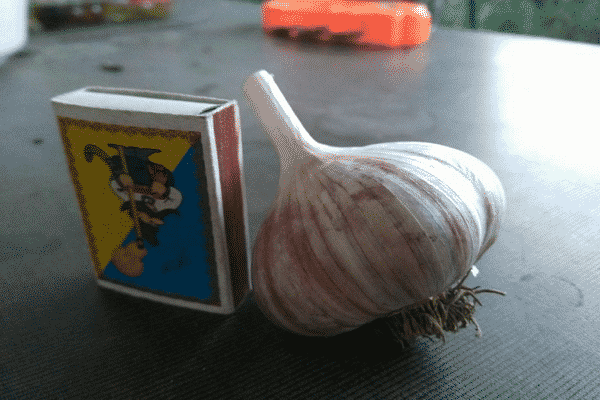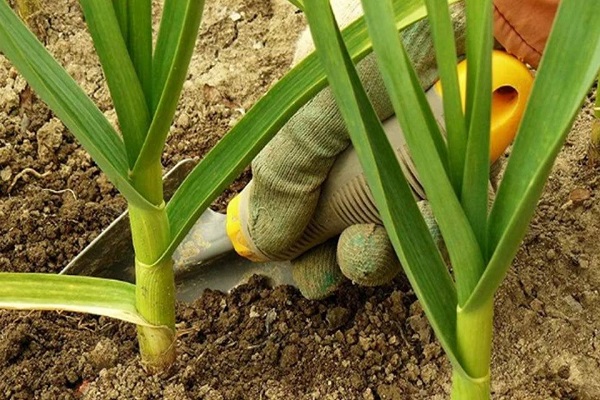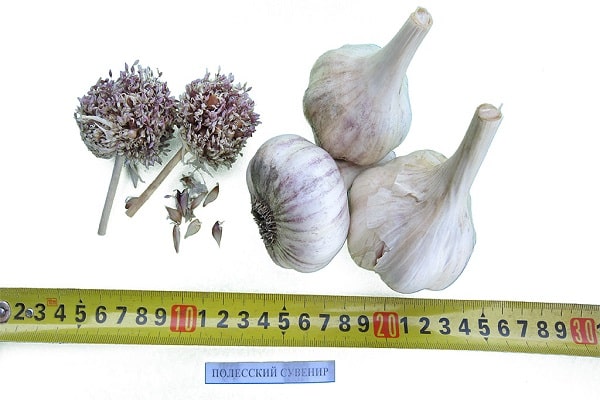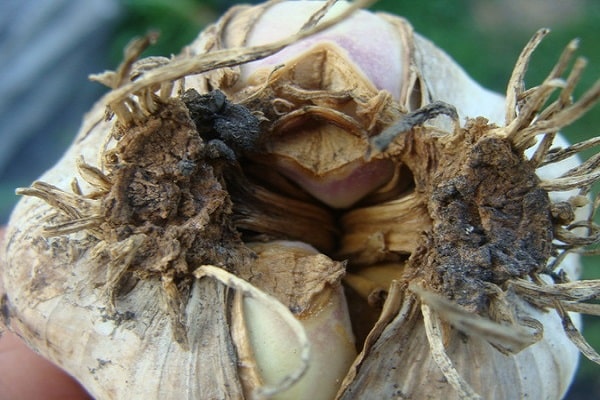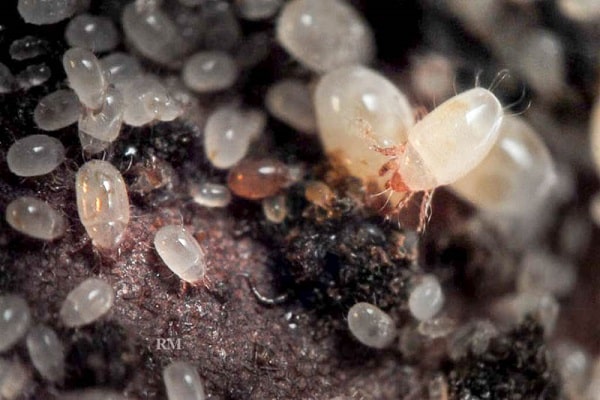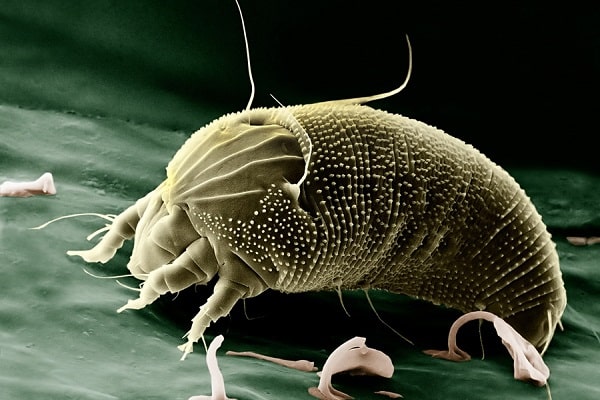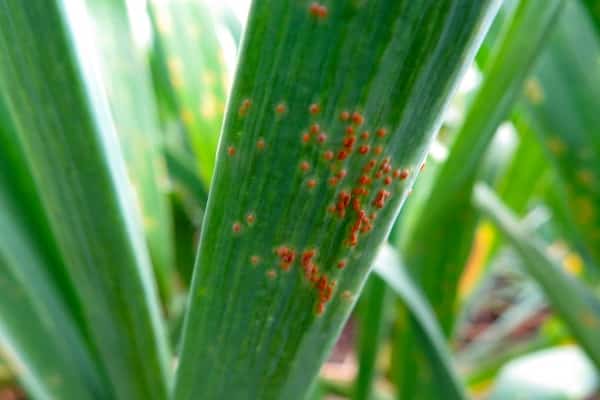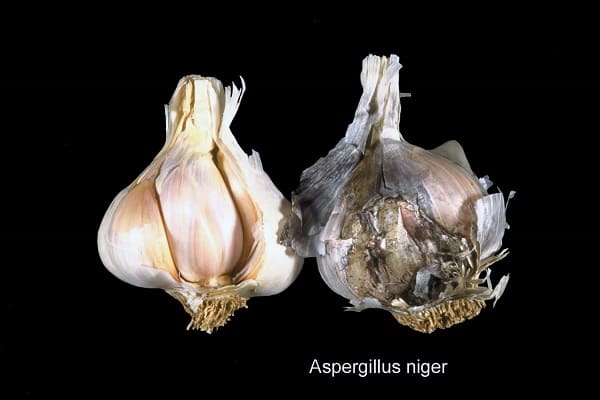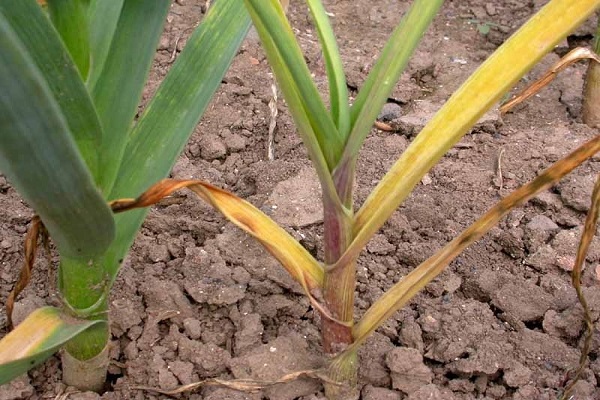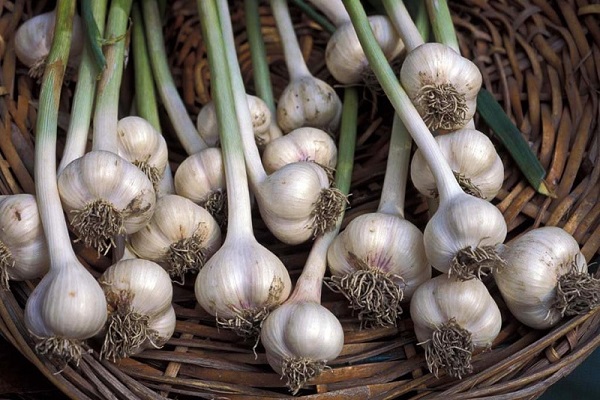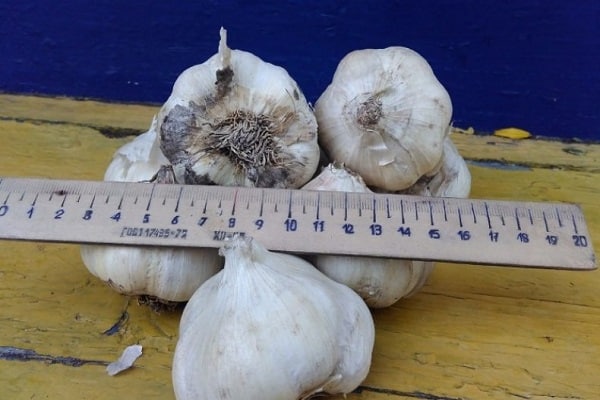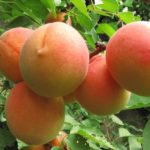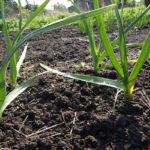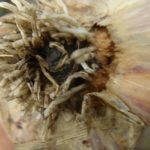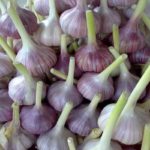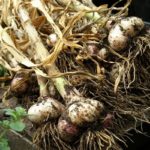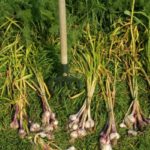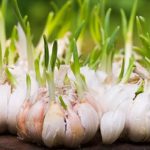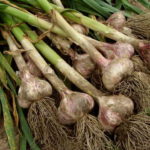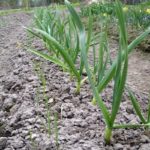Garlic is one of the most popular agricultural crops in the world; it has been known since ancient times and is grown in most countries. It is used in cooking, using both raw and dried as a seasoning, and even in medicine, due to its antiseptic properties. Today in the world there are many varieties of garlic, designed for different planting times, sizes of the future vegetable and taste. We will talk about one of the new varieties in this article.
Description of the variety
This variety was bred in Belarus in 2008, initially it was used only for industrial needs, since harvesting could be carried out using special equipment. Over time, it penetrated the regular consumer market and was warmly received by gardeners.
Garlic leaves have a rich green color with parallel veins. They are about three centimeters wide and can reach up to sixty centimeters in height. The garlic shoot splits into ten leaves. The average weight of the head is 100–150 grams, there are usually 6 purple cloves inside, and the husk is pinkish. The taste is spicy, the pulp is medium in density.
The growing season of this variety ranges in duration from 90 to 100 days. It tolerates even severe frosts well and has incredible productivity. Usually over 97 percent of what is planted germinates. When planted on an industrial scale, they harvest about twelve tons per hectare, which is also an impressive figure. It can be stored from six to eight months in properly selected conditions.
Growing
Polesie garlic is a winter variety, which means you need to worry about planting in the fall. Such varieties are usually larger and more valuable than spring varieties. The whole process can be divided into three stages: preparation of seed, soil preparation and, directly, planting.
We will now cover each stage in detail.
First stage: preparation of seed material
To achieve maximum taste and yield, preparation should begin ten days before planting. First, soak the cloves in a special preparation, it can be found in gardening departments and stores. This drug will provide initial immunity to garlic, protect it from parasites, rot and fungi immediately after planting.After 2-3 hours, remove and place at some distance from each other on newspaper to dry.
For those who constantly live in the country or in a private house, it will be convenient to spread newspapers on the veranda, and city residents can use the balcony, or secluded places where pets cannot reach.
Over the next ten days, it is important to maintain the temperature no higher than fifteen degrees and low humidity, this is necessary for the garlic to get used to the temperature regime. The teeth ready for planting should be dry, without signs of damage, mold or other defects.
Stage two: soil preparation
Experienced gardeners recommend planting garlic of the Polessky Souvenir variety in the beds vacated by tomatoes, cucumbers or green peas. The second good option is soil after cabbage, pumpkin or zucchini. The soil remaining after these crops is fertilized and saturated with useful organic components, which will help with growth.
Do not use areas previously allocated for potatoes or onions for planting; due to many similar diseases, there is a risk of ruining all plantings.
It is also better to avoid areas of the garden that were fertilized with manure less than a year ago if you want to get juicy and dense garlic; manure will only contribute to the growth of tops. If possible, use a special device to measure the acidity of the soil in different parts of the garden. For garlic, choose a corner with low acidity, facing a sunny, southern place.
At the end of August, closer to the time of planting, you need to fertilize the soil. Here's what you'll need for 1 square meter of area:
- humus - 10 kg;
- Potassium sulfate - 2 tbsp. spoons;
- ash - 200 g;
- chalk - 1 glass;
- superphosphate - 1 tbsp. spoon.
Mix all ingredients and spread in an even layer over the selected area. Then dig it up to the depth of a shovel (about 20 centimeters).
The next day you can start forming the beds. Plan the area so that the width is 90–100 cm and the height is 25 cm. Now you need to give the soil some time to shrink. If the process is moving slowly, water the future bed several times or leave this work to rain.
Some people believe that the soil should not be given time to shrink and plant immediately. This is wrong because the garlic is too deep and germination takes up more time and resources, resulting in lower yields.
Third stage: disembarkation
On the marked bed, make holes with an interval of ten centimeters from each other. The depth should be up to 15 centimeters. We press the cloves inside the holes and sprinkle with soil. Next, you need to mulch the beds; for this, use, for example, fallen leaves. If you live in the southern regions, you can skip this step.
Seedling care
The first condition for a good harvest is proper care. As soon as the first shoots appear, three procedures will need to be carried out regularly:
1) Loosening. Here it is important to loosen not only the top layer of soil, but to go deeper by 3–4 centimeters. This is necessary so that high humidity does not destroy the fruits under the hard earthen crust.
2) Watering. Depending on the amount of precipitation in the region, adjust the frequency and abundance yourself. Do not allow it to dry out for a long time, as this can destroy the plants.
3) Feeding and fertilizers. We live in an age of abundance; every gardening store has a large selection of fertilizers for every vegetable.Just remember to do it in a timely manner.
Advantages and disadvantages of the variety
Advantages:
- Large fruits.
- High yield.
- Tolerates frosts well.
Flaws:
- Requires careful preparation, care and fertilization.
- Vulnerable to diseases and pests.
Pests and diseases
Garlic often becomes a victim of pests and a target for diseases, Polesie souvenir is no exception. Here are the main problems that a summer resident may encounter.
Pests:
Stem nematode
It looks like a small, less than 1.5 mm, white worm, but can quickly destroy the entire crop. More often found on clay soils. They suck the juices out of plants, after which they dry out and die. If you are affected by this scourge, use special drugs to combat them. It will not be possible to plant garlic on the site for another 4 years, because the nematode overwinters in the soil and wakes up again with the arrival of warm weather.
Onion mite
It enters the garden bed along with infected seed. This is why it is so important to carefully inspect them before planting. You can prevent it from getting in if you prepare the teeth for planting in the manner indicated above. If it is already in the garden, it will be difficult to deal with it, most likely the fruits will rot.
Four-legged tick
It is more often found on spring varieties, but does not disdain winter ones. Ticks dig in and suck out the sap from the plant, but the main danger is that it is a carrier of diseases.

Diseases
Rust
It appears as rusty or red spots on the leaves; if it spreads strongly, it can completely cover the arrows. Often found in all regions of Russia.
Black mold
It first causes yellowish spots to appear, which are soon covered with dark spores.It can more often be found on weakened plants and at high humidity.
Fusarium
It appears as brown stripes on the leaves. With severe neglect, the leaf turns completely brown. Roots die almost immediately when infected. The source of infection is soil.
Harvest and storage
Garlic is harvested in mid-July. Dry indoors or on the veranda for about a week, then store in a dry and dark place for up to 8 months.
Reviews
Polesie souvenir, despite its short existence on the agricultural market, receives wonderful reviews from summer residents. Its size, yield and taste outweigh the need for such careful preparation and care.

